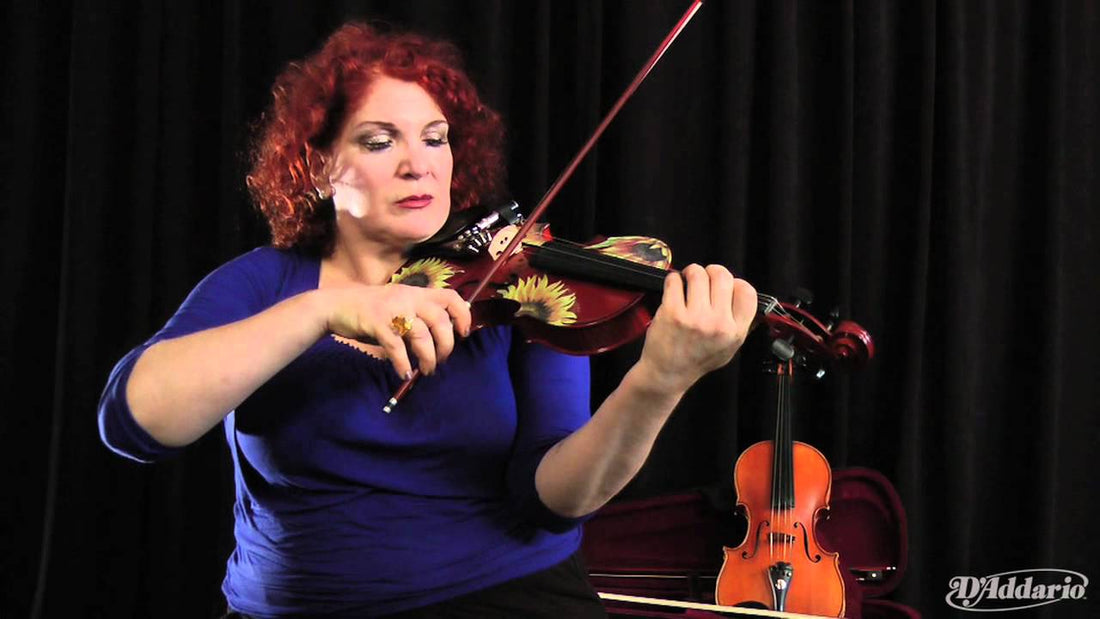What size violin does my child need, and how important is the size?
This is a question I often hear and one in which there may be strong viewpoints in answering this question. Some teachers consider it extremely important that the instrument size coincide with the age and size of the child. I, myself, am less concerned about getting the perfectly sized violin than I am with how the child is taught to approach the physicality of 'holding the violin.' In fact, rather than calling it 'holding,' I would replace the world with 'balancing.'
Violin size is only an issue for children. The most frequently used fractional sizes are 1/16, 1/8, 1/4, 1/2, 3/4, 4/4, or full size. In general, adults will always use a 4/4, but in some cases, an adult may prefer the ease of a 3/4 or even 7/8 size, and some teachers insist on a 1/10 violin, which is slightly smaller than a 1/8. Still, I must admit that these slight differences are not so significant if a child is learning to balance the violin. Just as an acrobat or highly skilled athlete can make minute balance changes in various situations, if the student is sufficiently relaxed when holding the violin and not grabbing on for dear life with the head and shoulder, it should be possible for the child to adjust to the size and weight of balancing the violin.

I recall vividly watching my friend Sophie Arbuckle practicing with her quartet for an upcoming performance. During a break from practice, her intelligent 2 yr old, Shira, took hold of Sophie's viola, which was resting in its case on the floor, and managed to position the instrument on her left shoulder, much like her mother had been seen to do earlier. And no sooner did Shira (the 2 yrs old at the time) manage to hold the viola. She commenced to make plucking sounds using her right hand. How could this be possible? For the same reason that a highly skilled acrobat always manages to land on their feet, the body will find a way to balance a violin, regardless of the size.
How could this be possible? If given the right conditions, the body will kinesthetically find a way to balance a violin, regardless of the size. While having a 2 yr old play on a full size viola is impractical long term, this example does demonstrate how young children can learn to adjust to the instrument when given the right conditions to find a way to balance it.
Practically speaking, there are basic considerations that parents ought to keep in mind. The most important is that the player be able to comfortably outstretch the arm to reach the scroll and still have the elbow slightly bent. It should never look like the student is straining to reach the scroll of the violin.
Primary Considerations
Perhaps, most notably when holding the violin, if there is excess tension in the neck or shoulder, that will result in a diminished ability to extend the arm to its potential distance.

In particular, the distance from the neck to the arm. Certainly, this is a practical matter with the hope that finding the correct violin size will make it easier for the child to manage and learn to play the violin. This young lady is playing on a violin that is the right size, proportionate to her body, and arm's length.
The following is a basic chart that shows the recommended violin size based on age and size considerations. Consider the physical measurements of the child, such as the distance from the neck to the arm. Finding the correct violin size based on these measurements will ensure that the child can easily manage and learn to play the instrument.


Violin hold is one of the biggest enigmas for many string players, from beginners to advancing players. Sure, it's easy enough to grip the violin between the head & neck like a vice until the pain becomes incapacitating. It is possible to consider pain a necessary trade-off for playing a beautiful musical instrument.
While there are various theories on how to get around this issue, many of which involve a shoulder rest or other such device to position the violin to the body, such methods can also short-circuit the potential to balance the instrument. Why is this? Balance is an active experience with subtle changes and adjustments. Positioning and gripping an instrument, even slightly, is a far more static approach.
Mind you, plenty of string players have to deal with a long neck or sense that the distance between the head & shoulder needs to be filled up in some way. There are case-by-case physical considerations. Still, how we understand how to carry our upper bodies is a big piece of the puzzle.
Ultimately the player must discover where the real support needs to take place. Suffice it to say if the upper body is sufficiently supported by those illusive abdominal muscles most people engage when doing such activities as pilates, dance, and other spine-lengthening activities; the player will be less inclined to elevate the shoulders, which to a large degree can passively rest atop the rib cage rather than be used to hold the violin and body up. Using the shoulders in this manner could be more efficient.
Observations:
Raise the left shoulder and tilt the head as if trying to touch each other. Now outstretch the arm as if about to play the violin. How easy is it to extend the arm?
Bring the arm down. This time bring up the arm with a slightly bent elbow as if playing the violin. Of course, there's no need to raise the shoulder or squeeze the head since there's no instrument to contend with. But imagine if it were possible to play while maintaining a similar feeling of length in the neck and shoulder!
Try touching your nose with your fingers and notice how easy a movement that can be. And yet when navigating a similar distance on the fingerboard, it can feel treacherous while holding the violin or viola. A decrease in squeezing the neck & shoulder makes it so much easier to get around the instrument.

